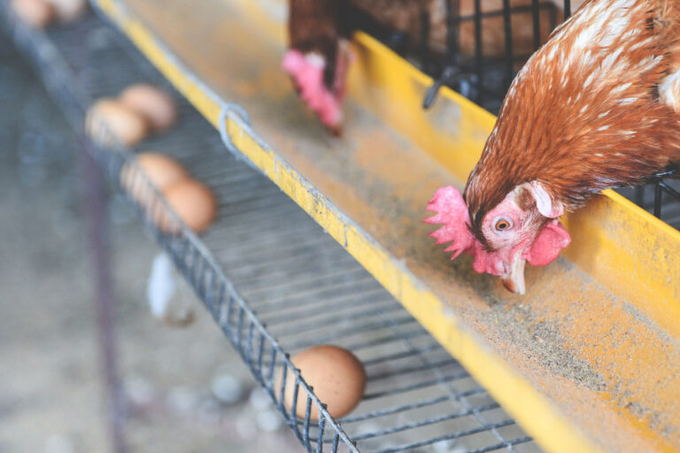June 19, 2025 | 07:08 GMT +7
June 19, 2025 | 07:08 GMT +7
Hotline: 0913.378.918
June 19, 2025 | 07:08 GMT +7
Hotline: 0913.378.918

In experimental tests, the robot achieved a detection accuracy of 90.61%. Photo: Canva.
At present, farm staff have to manually check each caged hen and promptly remove any dead birds to prevent the spread of diseases within cages.
The study, led by researchers from the Information Technology Research Centre at the Beijing Academy of Agriculture and Forestry Sciences, wanted to see if robots could streamline the process. They developed a specialised robot to enhance inspection efficiency, reduce manual labour and enable rapid identification of dead hens,
Technologies such as deep learning for real-time detection and identification, QR code-based positioning for precise localisation and autonomous navigation for seamless movement through the farm are utilised. It automates the otherwise tedious inspection process by visualising and pinpointing the location of dead hens within the cages.
In experimental tests, the robot achieved a detection accuracy of 90.61% by incorporating a supplementary lighting system, setting an inspection speed of 9m per minute and fine-tuning the algorithm with a probability value parameter of 0.48 and an area ratio parameter of 0.05.
Additionally, the robot demonstrated a low false detection rate of 0.14% and a minimal obvious false detection rate of 0.06%.
Compared to traditional manual inspection methods, the robotic system not only automates the task but also significantly reduces labour requirements and improves the overall management of efficiency of large-scale egg farms.
With its high accuracy and speed, the researchers say the robot presents a viable solution for modern poultry operations, ensuring timely removal of dead hens and contributing to better farm hygiene and animal welfare.
(Poultryworld)
![Turning wind and rain into action: [9] Digitizing hydrometeorological data in response to climate change](https://t.ex-cdn.com/nongnghiepmoitruong.vn/608w/files/news/2025/06/17/z6704423696987_15fd32ffc26d590d204d520c9dac6786-nongnghiep-165943.jpg)
(VAN) Farmers have begun accessing hydrometeorological applications to adjust their cropping schedules, aiming to ensure productivity and adapt to climate change.
![Turning wind and rain into action: [8] Real-time salinity detection and early warning technology](https://t.ex-cdn.com/nongnghiepmoitruong.vn/608w/files/news/2025/06/17/z6704423696987_15fd32ffc26d590d204d520c9dac6786-nongnghiep-151127.jpg)
(VAN) Thanks to the integration of modern hydrological-hydraulic models, remote sensing technologies, and artificial intelligence, the accuracy of hydrological forecasting has significantly improved.
![Turning wind and rain into action: [7] Early disaster warnings help marine farmers minimize losses](https://t.ex-cdn.com/nongnghiepmoitruong.vn/608w/files/news/2025/06/17/z6704423696987_15fd32ffc26d590d204d520c9dac6786-nongnghiep-142942.jpg)
(VAN) In recent years, thanks to early disaster warnings and forecasting, marine farmers in Khanh Hoa province have been able to reduce risks and losses, thereby improving production efficiency.
![Turning wind and rain into action: [6] ‘Four on-the-spot’ disaster management software](https://t.ex-cdn.com/nongnghiepmoitruong.vn/608w/files/news/2025/06/17/e5a48259d6a262fc3bb3-nongnghiep-183800.jpg)
(VAN) By simply activating the scenario on the disaster management software, the relevant authorities immediately know how many households need to be evacuated, where to evacuate them to, and by what means of transportation…
![Turning wind and rain into action: [5] Hue applies modern technology in disaster forecasting](https://t.ex-cdn.com/nongnghiepmoitruong.vn/608w/files/news/2025/06/17/z6704423696987_15fd32ffc26d590d204d520c9dac6786-nongnghiep-093938.jpg)
(VAN) In Hue city, modern technology has recently been applied in meteorological and hydrological forecasting and warning, helping to reduce the damage caused by natural disasters.

(VAN) A cutting-edge farming technique being implemented on an experimental ranch in Arizona's Sonoran Desert has already saved a billion gallons of water over five years, according to Civil Eats.

(VAN) Poultry and pig production and the environment can be boosted through enhanced water technology, according to new research.